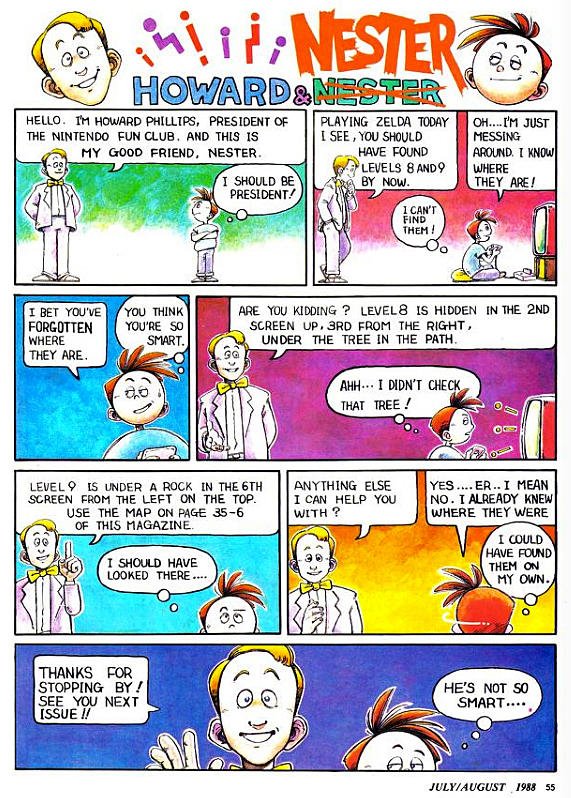Periodical Personality
By Darren Hupke
Video game magazines in the 80s and 90s followed a familiar template. News, previews and reviews.
Which meant standing out from the competition and building a fanbase was all about the personality of the publication and its associated writers.
Well aware of this, magazines like GamePro, EGM and Nintendo Power worked hard to develop unique identities, often turning their writers into larger-than-life characters. Like a comic book, each issue built on what came before and featured recurring characters, themes and in-jokes.
All these years later it’s this sense of personality that we remember more than any individual preview, review or feature.
Nintendo Power and newsstands
Before I subscribed to any magazines, every visit to the grocery store was an opportunity to scan the newsstands for the latest releases. I had my favourites, and if there were a recent issue of EGM it would top my personal list of "buy it now" magazines. If I had the latest issue I might check out alternative options like NextGen, GamePro, Game Players/PSM, etc.
After months of this routine I gravitated towards certain magazines because of their personality. I’m sure you noticed this about your favourites too. The way their personality and tone aligned with your own outlook. As an adult, I often think about the variety of publications back in the day and how each magazine found its own identity.
I mentioned before that gaming magazines were like comic books, which was quite literal in the early years. Nintendo Power first launched in 1988, evolving from their Nintendo Fun Club News, and in their first issue, they had a comic strip called Howard and Nester. Howard represented Howard Philips, a Nintendo of America employee. Nester was an original character representing all kids growing up with an NES.
Nintendo Power never featured or highlighted their editors or reviewers significantly early on. The personality of the magazine came from Nester. Once Nintendo Power began giving annual awards, they were shown as illustrated Nester-shaped trophies and were called Nesters. Every magazine issue ran a Howard and Nester comic strip that would evolve into Nesters Adventures up to December 1993. Beyond the magazine, Nester also appeared in games like NES Play Action Football and was referenced in a few others.
GamePros and avatars
GamePro magazine launched in April of 1989. It was a multi-format magazine and even covered the PC. Where Nintendo Power focused on gaming tips and strategy guides, GamePro was all about the latest news and releases across the broader industry.
Evolving from the quirky Nester in Nintendo Power, the entire GamePro staff sought to project themselves as larger-than-life comic book heroes. They referred to themselves as the ‘GamePros’ and had names like The Eliminator and The Pro A.J.F.
Issue two saw a monthly comic strip launch, The Adventures of GamePro. It was illustrated by Francis Mao, who would go on to design the individual GamePro staff writer avatars we know and love.
As a younger reader, I liked this cartoony charm. I enjoyed getting the comics inside each issue. Once they brought out their famous (illustrated) review scoring system and explained that these were just the opinions of the individual GamePros I started paying more attention to who was reviewing what and taking note of personalities. I still remember Scary Larry, Major Mike, and the GamePro crew. Who doesn't immediately see that 5.0 WOW face when thinking about a GamePro Pro Review?
EGM and beyond
As I got older, my taste for content changed. I had my bias and fandom established. I had my opinions and was ready to debate with friends at school about which system was better and what games topped the greatest of all-time list. At this age, I found myself gravitating towards Electronic Gaming Monthly (EGM).
While EGM started around the same time as GamePro, and had their own identities like Trickman Terry, the Quarterman, and Sushi-X, for me, their rise in popularity and quality hit around 1996 when Ziff-Davis became the new publisher. That’s when people like Dan ‘Shoe’ Hsu, Crispin Boyer, Shawn Smith, and other new editors joined the magazine.
My biggest draw was that EGM featured a multi-person Review Crew. With each issue, you had a minor update on what the editors were doing that month and their current favourite games. This peek at the real people involved and seeing the monthly updates established a more profound connection for me as a reader.
Following my favourite editors was a precursor to the internet and social media. It felt like these were people just like me. This evolution from comics and characters into this grounded and approachable crew was just what readers were looking for as the 90s came to a close and the new millennium and new generation of games were coming. To this day, I remember Shoe's love for the Michigan Wolverines, Milkman and his odd taste in titles that I always aligned with, John Davison teaching about the UK, and all the other great people over the years.
Honourable mentions
While I only touched on some of the more iconic titles of the era, many other magazines contributed their own fingerprints to the newsstands in different ways. Honourable mentions need to go out to NextGen for always going deeper and having thorough cover stories and content that other magazines couldn't (or wouldn't) do.
PSM was a personal favourite of mine, with their eye-patched smiley icon plus their Nester-like mascot, Banzai Chibi-Chan, and the personality of their editors in every issue like EGM. The Official US PlayStation magazine was published by Ziff-Davis alongside EGM so that always felt like an extended family and extension of that magazine. Lastly, Game Informer had a fantastic run, likely due to the financial backing and pipeline GameStop could give it. Still, Andy McNamara, Andrew Reiner, and their crew always spoke to the reader transparently and offered that personal connection like the best of them.



